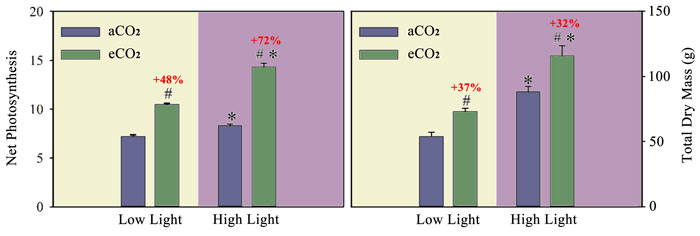| Tweet | Follow @co2science |
Paper Reviewed
Marcal, D.M.S., Avila, R.T., Quiroga-Rojas, L.F., de Souza, R.P.B., Gomes Junior, C.C., Ponte, L.R., Barbosa, M.L., Oliveira, L.A., Martins, S.C.V., Ramalho, J.D.C. and DaMatta, F.M. 2021. Elevated [CO2] benefits coffee growth and photosynthetic performance regardless of light availability. Plant Physiology and Biochemistry 158: 524-535.
In the words of Marcal et al. (2021), "the combined effects of elevated CO2 and light availability have been seldom investigated in crop species." And so it was that this team of eleven scientists determined to carry out what they assumed to be the first such study for the coffee plant (Coffea Arabica, cv Catuaí Vermelho IAC 44).
Their experiment was conducted in open-top chambers inside a greenhouse with "naturally fluctuating conditions of air temperature, air humidity and photosynthetic photon flux density" in Vicosa, south-eastern Brazil. Coffee seedlings were subjected to one of two CO2 concentrations (ambient or elevated, corresponding to 380 or 740 ppm, with the elevated CO2 being supplied between the hours 0600 and 1800 daily) and one of two light levels (low or high, corresponding to approximately 7.5 and 16 mol photons m-2 d-1, with the low light level achieved via black nylon nettings that did not impact light quality). Routine cultivation practices were followed during the 180 day experiment, including adequate fertilization and water supply. And what did the experiment reveal?
Out of the 44 variables examined related to photosynthesis, growth, nitrogen and pigment, and metabolites, Marcal et al. report that 39 were significantly affected by light, CO2 or their interaction. In particular, they note that "variations associated with growth and biomass traits were mostly explained by the factor [of] light, whereas variations linked to photosynthetic traits were mostly explained by the factor [of] CO2. We note, however, based on the data presented in Figure 1 below that elevated CO2 stimulated net photosynthesis by 48% under low light conditions and a much greater 72% under high light conditions. Similarly, elevated CO2 led to biomass increases of 37% and 32% in the low and high light treatments, respectively.
Figure 1 also illustrates that across all treatments the greatest plant performance in terms of photosynthesis and biomass occurred in the combined high light and elevated CO2 treatment. According to the authors, this occurred via "morphological alterations that were orchestrated at the whole-plant level, as noted for the increased leaf number (and total leaf area) that was associated with improved development of plagiotropic branches. More of these branches imply more nodes for accommodating the larger number of leaves that are formed in response to both high light and elevated CO2 conditions. Secondarily, higher total leaf areas couples with physiological adjustments, such as a higher net carbon assimilation rate per unit leaf area, will provide increased assimilate availabilities to enhance plant growth."
Altogether, the findings of this research paper bode well for the future growth of coffee plants. Whether grown under low light or higher light conditions coffee plants will benefit from the ongoing rise in atmospheric CO2.

Figure 1. Net photosynthesis (umol CO2 m-2 s-1) and total dry mass of coffee plants grown under ambient or elevated CO2 concentrations (380 ppm and 740 ppm, respectively) at two different light intensities (low or high, corresponding to approximately 7.5 and 16 mol photons m-2 d-1, respectively). Asterisks (*) indicate differences between light regimes within the same CO2 supply and hashtags (#) indicate differences between CO2 treatments within a same light regime (P ≤ 0.05, F test, n = 7 ± SE). Source: Marcal et al. (2021).




